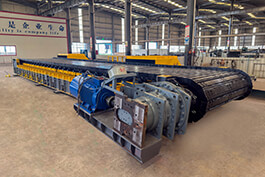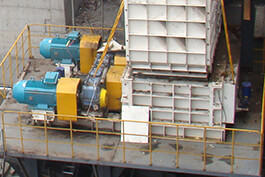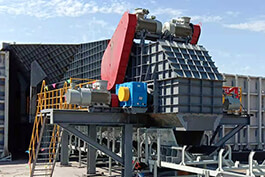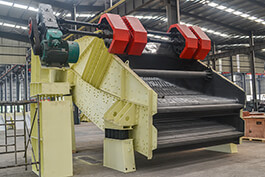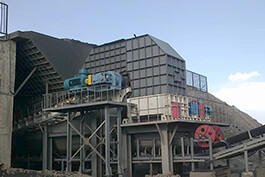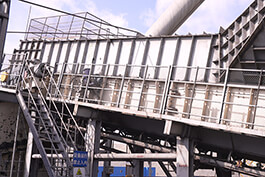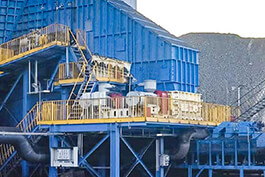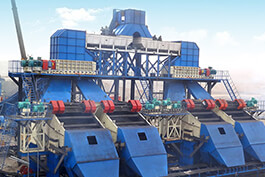The roller screen is driven by an electric motor to rotate the reducer at different speeds. Then, through the bevel gear box, it separately drives each sieve shaft to rotate in the same direction. This causes the material to move forward along the sieve surface. At the same time, it agitates the material. Particles smaller than the sieve hole gap are affected by their own weight and the rotational force of the sieve shaft and fall through the sieve holes. Particles larger than the sieve hole remain on the sieve surface and continue to move forward to enter the coal crusher.
Existing problems
The design structure of the gearbox is unreasonable
The gearbox is of an overall disassembly type. The segments of the box are connected in a tile-like continuous insertion structure. Each time any internal component needs to be inspected and repaired, the gearbox cover needs to be completely disassembled. Due to frequent disassembly and repair, some bearing chambers have been damaged, the fixed bolt holes have failed, and the gearbox is unable to maintain normal operation. Additionally, due to the insufficient design space between the gearbox and the output shaft coupling, each time the gearbox is repaired, the fixing bolts of the output bearing end cover need to be destructively removed.
The shaft seal of the sieve shaft is not tight
The original shaft seal of the sieve shaft and the box was a felt strip seal. The felt strips were frequently damaged, and dust leaked from the inner holes of the end covers on both sides of the sieve shaft and between the sieve shaft and the end covers. The leaked dust accumulated at the bearing seats on both sides of the sieve shaft, and as the sieve shaft rotated, it entered the bearing seats through the oil seal of the bearing seat frame, causing poor bearing lubrication, ultimately leading to overheating of the bearings, frequent damage, and wear of the shaft neck at the installation position of the bearing on the sieve shaft.
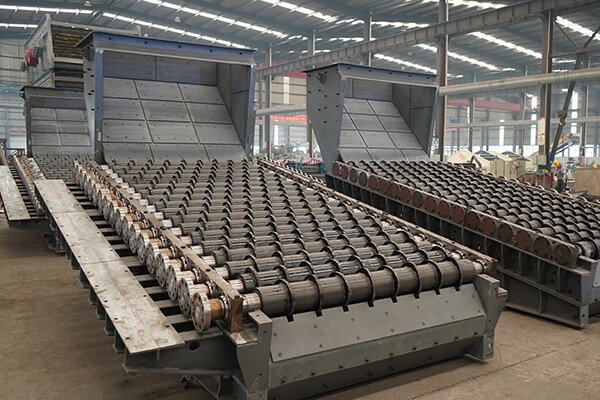
There are defects in the lower box plate, sieve shaft, and coupling
The lower box plates on both sides of the roller screen‘s sieve shaft are severely corroded due to factors such as material impact and dust corrosion; the wear of the sieve plates and cleaning plates on the sieve shaft has exceeded the specified requirements, unable to effectively complete the material screening and cleaning operations, and directly affecting the screening efficiency and quality; the structural bolt holes of the coupling of the sieve shaft have been severely worn and deformed due to long-term force and wear, resulting in obvious deformation and vibration and abnormal noise during operation, and even the possibility of the coupling falling off and other safety hazards.
The original design of the cleaning device is unreasonable
The angle steel of the fixing frame of the cleaning device's cleaning blade is prone to bending and deformation during the welding process of the cantilever, and the weld seam often opens and falls off. In addition, the comb plate is installed vertically with the sieve shaft, and it is prone to deformation under bending pressure during operation.
In recent years, the bolt holes of the failed gearbox have been expanded, and the bearing chambers have been repaired with filling glue. The sieve shaft was shifted to the front and back, the shaft seal of the sieve shaft adopted the remedial method of adding a frame-type shaft seal, and the rotation angle of the coupling of the sieve shaft was swapped and re-drilled, but the equipment still could not maintain normal operation.
Operation and Maintenance, Common Fault Handling
Operation and Maintenance
(1) Before starting, check whether all the foundation bolts of the Roller screen bearing seat, motor reducer, and gearbox are complete and securely fastened.
(2) Before starting, confirm that all observation doors are closed. It is strictly prohibited to enter or extend tools to clean debris without power off.
(3) After the Roller screen is just put into operation, focus on checking the current of the motor, the temperature of each bearing, as well as whether the vibration and sound are normal, and whether the foundation bolts and connecting bolts are securely fastened.
(4) During the operation of the Roller screen, the cleaning blades under the sieve plate are prone to get stuck with soft debris. They need to be cleaned regularly to prevent excessive accumulation of debris from causing wear on the sieve plate.
(5) After each stop of the Roller screen, check if there are any blocked materials on the sieve surface and clean them.
(6) Regularly check whether the oil level of the reducer meets the requirements and add lubricating oil of the appropriate type. Regularly inspect the lubrication of the sieve shaft, bearings, and gearbox.
Common Fault Handling
(1) The sieve plate and single-sex nylon pin are wear-prone parts. If they are cut or damaged, check whether there are iron objects, coal gangue, etc. stuck in the sieve shaft. After identifying the cause of the fault, replace them in time.
(2) If during normal operation, abnormal current, temperature, sound, or vibration is detected, stop the machine for handling.
(3) If the motor or reducer shows abnormal vibration, noise, or overheating, check whether the foundation bolts are loose, and whether the motor reducer is damaged.
(4) If there is a pile-up situation during the operation of the Roller screen, consider reasons such as the coal quality being wet and sticky, excessive debris, blockage of the sieve chute below, and excessive coal feeding volume. At this time, stop the machine to clean the sieve surface or appropriately reduce the coal feeding volume.
Conclusion
The roller screen, as a key equipment in the material screening process, its operational stability and reliability directly affect the efficiency and quality of the entire production process. Through in-depth analysis of the existing problems of the roller screen, combined with equipment operation maintenance and fault handling, targeted structural optimization, material upgrading and process improvement measures are implemented.



